This colorful day-flying moth is one of the most delightful flower visitors to watch moving through a flower patch in the garden. Hummingbird-like in behavior, these moths hover in front of their favorite flowers, sipping nectar with their long tongues. Not only can they hover, but they even sound like a hummingbird with their fast-moving wings emitting a low humming noise. It is not uncommon for people to mistake these moths for small hummingbirds.
If you are interested in attracting these pollinating moths to your garden, you need to provide food for the adults and the caterpillars. Read on to find out which plants will fulfill their needs.
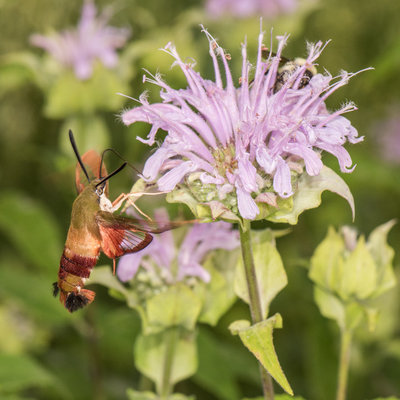
Holm Design & Consulting LLC
Family: Sphingidae (sphinx moths)
Genus: HemarisCommon name: Clearwing moth
Distribution: Snowberry clearwing moth (
Hemaris diffinis): U.S. and southern Canada;
slender clearwing moth (
Hemaris gracilis):
U.S. and Canada east of the Rocky Mountains;
hummingbird clearwing moth (
Hemaris thysbe): eastern
U.S., southern and northwestern Canada;
Rocky Mountain clearwing moth (
Hemaris thetis):
North America west of the Rocky Mountains
Habitat: Woodland edges, gardens, meadows, prairies and field margins
When to look for them: During a warm spring in the northern United States, adults can be observed as early as May; the peak of adult activity usually occurs in July and August, when plenty of nectar plants are available to forage on.
Shown: A hummingbird clearwing moth (
Hemaris thysbe) visiting wild bergamot (
Monarda fistulosa)
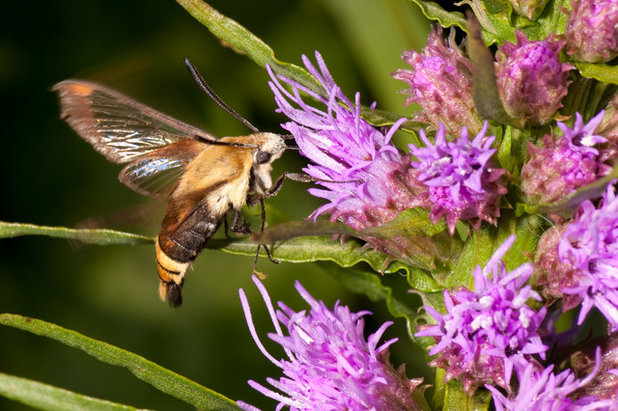
Holm Design & Consulting LLC
How They HelpClearwing moths are day-flying. Like all moths and butterflies, they have an extremely long proboscis (tongue), which allows them to access nectar in flowers with complex forms, such as a long, tubular set of petals. They also have the ability to hover while gathering nectar from flowers, which gives them access to flowers that hang downward or would be otherwise difficult to land upon.
Their relatively hairy bodies and long tongues pick up and transfer pollen as the moths forage on flowers, making them an effective pollinator in some cases, especially of flowers that require pollination by butterflies or moths (bees and other insect pollinators do not have long enough tongues). An example is phlox flowers; phlox flowers are self-incompatible and require pollen from another phlox flower to produce seed. Clearwing moths and butterflies transfer that pollen from one phlox flower to the next on their long tongues.
Shown: A snowberry clearwing moth (
Hemaris diffinis) visiting blazingstar (
Liatris sp.)
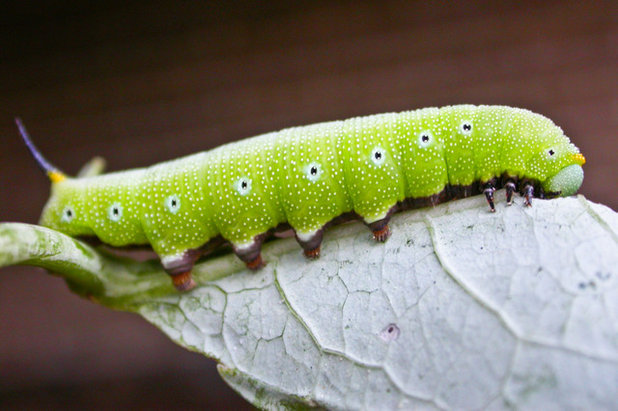
Holm Design & Consulting LLC
How to Spot Clearwing WaspsAdults: Adults are hummingbird-like but smaller, and like hummingbirds, they hover in front of flowers as their wings beat quickly and appear as a blur. It is also not unusual to hear these beautiful moths if you are standing or sitting quietly near their favorite flowers; their fast wing beats emit a low humming noise. At the end of the adult moths’ broad abdomen, they have a fan-like tail that likely helps them slow down or stabilize their body while they hover in front of flowers.
The snowberry clearwing moth (
Hemaris diffinis), in particular, mimics a bumblebee with its black and yellow coloration. This mimicry of a stinging insect provides the adults with some protection from avian predators. Adults range in length from 1¼ to 1¾ inches.
Babies (larvae): The larvae (caterpillars) all have a caudal horn (thorn-like appendage) at the end of their abdomen and are typically light to medium green in color; this coloration helps camouflage them while they feed on foliage. Snowberry clearwing caterpillars can also be brown to dark maroon in color, and hummingbird clearwing caterpillars can turn coral to dark maroon late in development.
Shown: A snowberry clearwing moth caterpillar (
Hemaris diffinis) feeding on a honeysuckle vine (
Lonicera sempervirens), one of several larval host plants of this species
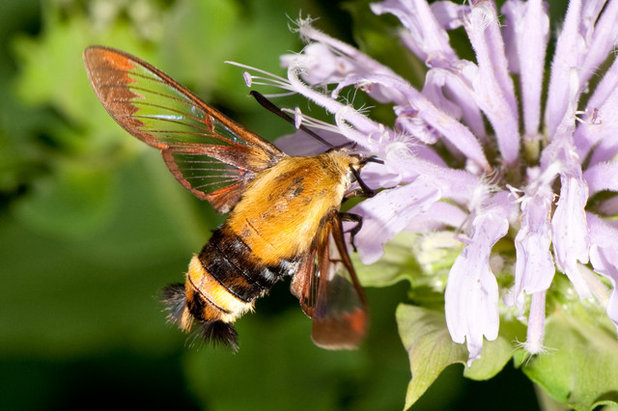
Holm Design & Consulting LLC
How to Lure ThemProvide larval host plants for caterpillars. While adults need nectar, the caterpillars (larvae) are foliage-feeders.
Common larval host plants for each species:
- Snowberry clearwing moth (Hemaris diffinis): Bush honeysuckle (Diervilla spp.), honeysuckle (Lonicera spp.), snowberry (Symphoricarpos spp.) and bluestar (Amsonia spp.)
- Slender clearwing moth (Hemaris gracilis): Blueberry (Vaccinium spp.) and possibly other plants in the Ericaceous family
- Hummingbird clearwing moth (Hemaris thysbe): Viburnum (Viburnum spp.), honeysuckle (Lonicera spp.) and snowberry (Symphoricarpos spp.)
Maintain a pesticide-free yard. Don’t use pesticides, especially insecticides, in the garden, particularly on flowering plants.
Shown: A snowberry clearwing moth (
Hemaris diffinis) visiting wild bergamot (
Monarda fistulosa)
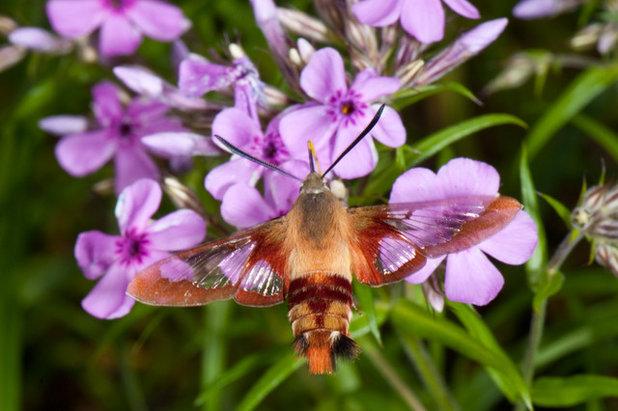
Holm Design & Consulting LLC
Provide forage plants for adults. Adults are nectar-feeders and visit a wide range of plants. They demonstrate a preference for plants with long, tubular corollas, or petals, of which other insect pollinators cannot access the nectar. On these plants, the clearwing moths find a higher nectar reward.
Sample plant list for adults:
Annuals: Salvia,
zinnia,
verbena,
petunia and
lantanaPerennials:- Spring: Virginia bluebells (Mertensia spp.) and violets (Viola spp.)
- Summer: Wild bergamot (Monarda fistulosa), swamp milkweed (Asclepias incarnata), garden phlox (Phlox paniculata), thistle (Cirsium spp.) and common milkweed (Asclepias syriaca)
- Late summer: Blazingstar (Liatris spp.)
Shown: A hummingbird clearwing moth (
Hemaris thysbe) visiting prairie phlox (
Phlox pilosa)
Browse native plants for your region
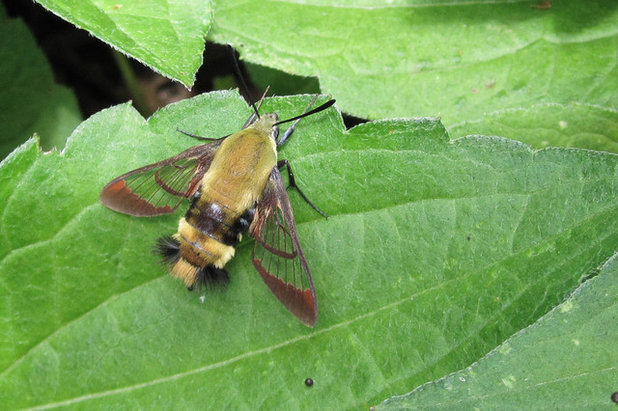
Holm Design & Consulting LLC
Life cycle. In the northern United States and southern Canada, clearwing moths produce one or two generations per year. In the central United States, they produce three generations per year, and in the South (Florida, Texas), these moths can reproduce year-round.
Females attract males to mate by emitting a pheromone produced at the base of the abdomen. After mating with males, adult female moths lay their eggs on the leaf of a larval host plant. The caterpillars, after hatching, feed on the host plant. As the caterpillars grow and develop, they molt, shedding their skin four times, transitioning from one instar (phase between periods of molting) to the next. In the fifth, and final, phase, caterpillars drop to the ground then and pupate in a cocoon in the leaf litter on the ground. In the upper Midwest, where one generation can occur, pupae spend the winter in the leaf litter.
Region by region: What to do in your garden this month





